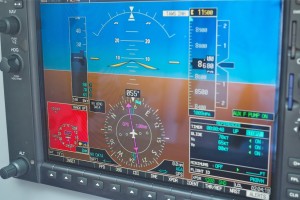 |
| Flying amongst the mountains and clouds |
I’ll try not to bore you with the technical formulas etc but basically the higher you go, the less dense the air is. Also, the warmer the air, the less dense it is. Now, combine these two facts and you end up with some pretty thin air.
 |
| 10,000ft indicated, 11700ft density altitude. Note the CAS and TAS differences |
That thin air effects aircraft in two significant ways: less power available from the engine and a faster true airspeed for the same indicated airspeed. But what does that mean in reality when flying out in the mountains?
 |
| On the ground in Agadugume |
Consider landing at an airstrip at 8700ft like Agadugume. Note the temperature here, 19C. That’s pretty warm for nearly 9000ft. Combine that warm temperature with the altitude and you end up with a pretty fast true airspeed. So whilst your airspeed indicator is reading the normal 65kts on approach, you’re actually doing 85kts over the ground, assuming no wind. That makes for a much faster approach and is effectively like trying to land with a 20kts tailwind (and more often than not at mountain airstrips you have a tailwind too, just to make the landing even more interesting).
 |
| Approach into Agadugume at nearly 9000ft |
What’s also noticeable when landing at high altitudes is the increased engine power required to maintain a normal approach speed and flight path. Thanks to the thin air, the wings are less effective at keeping you up in the air so if you do start to fall below your desired approach profile, it can require a significant amount of power to bring the aircraft back to where you want it, especially at all up landing weight.
 |
| Lined up for departure at Kilmit |
Take-offs are also compromised thanks to those hot and high conditions. The engine can be limited by either torque or temperature or even Ng (turbine rpm) which you must be aware of so as to not exceed any limitations. Even if you are able to get full power, you won’t be getting the same performance that you get at sea level. That means longer take-off rolls and reduced climb performance, both of which need to be considered if you’re on a short airstrip in a tight bowl that you need to climb out of.
If in doubt, don’t try and take-off with a full load. Although trying to explain the effects of all this to the dozens of locals trying to get into the aircraft for a ride out of their village can prove a little tricky at times!
Discover more from Matt Dearden
Subscribe to get the latest posts to your email.

Fascinating Matt. Your blogs are an inspiration and knowledge base for other pilots. Well done!
Thanks pa!